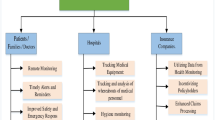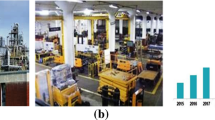Abstract
With Industry 4.0 and Internet of Things (IoT) era coming, remote passwords and control-flow vulnerabilities play a key role to detect attackers in Industry IoT (IIoT), who can easily complete remote session and control-flow hijacking on leverage of these types of Sensitive Information (SI). However, how to measure security degree of Sensitive Information is an open issue. To our best knowledge, no effective method can detect secret trace of SI thieves in Advanced Persistent Threat (APT), especially for backdoors and vulnerabilities in software or firmware. To deal with these problems, we propose a new design, called, IIoT-SIDefender (IIoT-SID), we measure security degree of Sensitive Information via Analytic Hierarchy Process (AHP) and Technique for Order Preference by Similarity to an Ideal Solution (TOPSIS), based on selected taint tracking and real-time memory modification, attack-defense and fix-distribution approaches are proposed. Until now, it is the first defined SI guard method to detect SI-leakage scenarios and reject SI-leverage attack. To verify our proposal, experimental tests are verified in a large number of IIoT applications and devices, including IP cameras, smart meters, PLCs and smart routers. Test results have demonstrated that we can capture security level for Sensitive Information as expected, detect potential leakage points in data lifetime (including unknown backdoors and vulnerabilities), describe fine-grained semantics of accidental leakage and secret leverage points, and generate relative hot fix to prevent further attack.







Similar content being viewed by others
References
Apa, L., Penagos, C.M.: Compromising industrial facilities from 40 miles away. BlackHat (2013)
Ariu, D., Tronci, R., Giacinto, G.: HMMPayl : an intrusion detection system based on hidden Markov models. Computers & Security. 30(4), 221–241 (2011)
BBC: (2016) Siemens' flaw' claim sparks US power plant security probe [EB/OL]. http://www.bbc.com/news/technology-19343131
Binwalk: [EB/OL]. http://binwalk.org/
Cai Z, He Z, Guan X, et al. Collective Data-Sanitization for Preventing Sensitive Information Inference Attacks in Social Networks. 2016, PP(99):1–1.
Chen, D.D., Manuel, E., Maverick, W., David, B.: Towards automated dynamic analysis for Linux-based embedded firmware[C]// network and distributed system security Symposium (2016)
Chinaunix.net: PowerPC feature [EB/OL]. http://blog.chinaunix.net/uid=20663797-id-35772.html
Collberg, C.S., Thomborson, C.: Watermarking, tamper-proofing, and obfuscation - tools for software protection[J]. IEEE Trans. Softw. Eng. 28(8), 735–746 (2002)
Costin, A., Zaddach, J.: Embedded devices security and firmware reverse engineering. BlackHat (2013)
Costin, A., Zaddach, J., Francillon, A., Balzarotti, D.: A large-scale analysis of the security of embedded firmwares. In: Proceedings of the 23rd USENIX Security Symposium. USENIX, pp. 95–110 (2014)
Costin, A., Zarras, A., Francillon, A., et al.: Automated dynamic firmware analysis at scale: a case study on embedded web interfaces[C]// ACM on Asia Conference on computer and communications security. ACM (2016)
David, Z., Jaeyeon, J., Dawn, S., et al.: TaintEraser: Protecting sensitive data leaks using application-level taint tracking. ACM SIGOPS operation systems Review. ACM: New York. 45(1), 142–154 (2011)
Davis, A.: Broadcasting your attack: security Testing DAB Radio in Cars. BlackHat (2015)
Dong, M., Ota, K., Yang, L.T., et al.: LSCD: a low-storage clone detection protocol for cyber-physical systems. IEEE Transactions on Computer-Aided Design of Integrated Circuits and Systems. 35(5), 712–723 (2016)
Garfinkel T, Pfaff B, Chow J, et al. Data life time is a systems problem. Proc of the 11th workshop on ACM SIGOPS european workshop. ACM: N. Y., 64–75 (2004)
Github: obfuscator-llvm/obfuscator [EB/OL]. https://github.com/obfuscator-llvm/obfuscator/wiki
HackDig: TP-Link http/ftp backdoor [EB/OL]. http://www.hackdig.com/?03/hack-2171.htm
Hu, Y., Dong, M., Ota, K., et al.: Mobile target detection in Wireless sensor Networks with adjustable sensing frequency. IEEE Syst. J. 10(25), 3641–3642 (2014)
Jim, C., Ben, P., Tal, G., et al.: Shredding your garbage: reducing data lifetime through secure deallocation. Proc of the 14th USENIX security Symp. ACM. N. Y. 104–118 (2005)
Lin, Y., Lee, P.-C., Tapeng, C., et al.: Multi-attribute group decISIon making model under the condition of uncertain information. Automation in Construction. Elsevier:Amsterdam. 17(1), 792–797 (2008)
Maskiewicz, J., Ellis, B., Mouradian, J., Shacham, H.: Mouse trap: exploiting firmware updates in USB peripherals. In: Proceedings of the 8th USENIX Workshop on Offensive Technologies. USENIX, pp. 1–10 (2014)
Matt, W., Sudhir, A., Michael, C., et al.: Testing metrics for password creation policies by attacking large sets of revealed passwords. Proc of the 17th ACM Conf on computer and communications security. ACM: New York. 162–175 (2010)
Neisse, R., Steri, G., Fovino, I.N., et al.: SecKit: a model-based security toolkit for the Internet of Things. Comput. Secur. 58, 78–87 (2015)
Ooi, S.T., Lorber, B.: Avatar: a framework to support dynamic security analysis of embedded systems’ Firmwares[C]// network and distributed system security Symposium (2014)
Plcscan: Security analysis for Mitsubishi [EB/OL]. http://plcscan.org/blog/2014/08/mitsubishi-electric-melsec-q-series-plc-analysis-report/
Reversemode.com: fix_function [EB/OL]. http://www.reversemode.com/images/stories/schneider/files/fix_function.idc
Reversemode.com: sysmbol_table [EB/OL]. http://www.reversemode.com/images/stories/schneider/files/sysmbol_table.idc
Rezvani, M., Ignjatovic, A., Bertino, E., et al.: Secure data aggregation Technique for Wireless sensor Networks in the presence of collusion attacks. Dependable & Secure Computing IEEE Transactions on. 12(1), 98–110 (2015)
Saied, Y.B., Olivereau, A., Zeghlache, D., et al.: Trust management system design for the Internet of Things: a context-aware and multi-service approach. Comput. Secur. 39(39), 351–365 (2013)
Santamarta, R.: SI labs: here be backdoors: a journey into the secrets of industrial firmware. BlackHat. (2012)
Schneier: Schneier on Security [EB/OL]. https://www.schneier.com/blog/archives/2010/07/security_vulner.html
Schwartke, H., Brüggemann, M.: PLC-blaster: a worm living solely in the PLC. BlackHat (2016)
Shih, H.-S., Shyur, H.-J., Lee, E.-S.: An extension of TOPSIS for group decISIon making. Mathematical and Computer Modelling, Elsevier:Amsterdam. 45(7), 801–813 (2007)
Shu, X., Zhang, J., Yao, D.D., et al.: Fast detection of transformed data leaks. IEEE Transactions on Information Forensics & Security. 11(3), 528–542 (2016)
Thomas, O.: Advanced IC reverse engineering techniques: in depth analysis of a modern smart card. BlackHat (2015)
Tone K, Manabe R. The casebook of AHP. JUSE Publishing Company: Tokyo, (1990)
Trendmicro: havex-targets-industrial-control-systems [EB/OL] havex-targets-industrial-control-systems
vmpsoft.com: vmprotect [EB/OL]. http://vmpsoft.com/products/vmprotect/
Wang, T., Wei, T., Lin, Z., Zou, W.: IntScope: automatically detecting integer overflow vulnerability in X86 binary using symbolic execution. In: Proceedings of the 16th Annual Networkand Distributed System Security Symposium (NDSS’09) (2009)
Weinmann, R.-P.; Baseband Attacks: Remote Exploitation of Memory Corruptions in Cellular Protocol Stacks. In: Proceedings of the 6th USENIX Workshop on Offensive Technologies. USENIX, pp. 1–10, (2012)
Wikimedia: BlackEnergy [EB/OL]. http://itlaw.wikia.com/wiki/BlackEnergy
Wikimedia: Information Sensitivity [EB/OL]. https://en.wikipedia.org/wiki/Sensitive_information
Wikimedia: Stuxnet [EB/OL]. https://en.wikipedia.org/wiki/Stuxnet
Wu, Y., Fahmy, S., Shroff, N.B: On the Construction of a Maximum-Lifetime Data Gathering Tree in Sensor Networks: NP-Completeness and Approximation Algorithm[C]// INFOCOM 2008. The Conference on Computer Communications. IEEE. IEEE, pp. 356–360 (2008)
Wu, J., Dong, M., Ota, K., et al.: Securing distributed storage for social Internet of Things using regenerating code and Blom key agreement. Peer-to-Peer Networking and Applications. 8(6), 1133–1142 (2014)
Yinqiang, Z Fabian M, Michael K, et al. The security of modern password expiration: an algorithmic framework and empirical analysis. Proc of the 17th ACM Conf on computer and communications security. ACM: N. Y., 2010; 176–186
Zhang, C., Wag, T., Wei, T., Zou, W.: IntPatch: Automatically Fix Integer Overflow to Buffer Overflow Vulnerability at Compile Time. European Symposium on Research in Computer Security (ESORICS’10) (2010)
Zhao, Q., Cao, T.: Collecting sensitive information from windows physical memory. Journal of Computers January, ACM: New York. 4(1), 3–10 (2009)
Acknowledgements
We thank the anonymous reviewers for their constructive and helpful feedbacks and suggestions. This work was supported in the National Science Foundation of China under grants (No.61373137), Major Program of Jiangsu Higher Education Institutions under grant No.14KJA520002.
Author information
Authors and Affiliations
Corresponding author
Additional information
This article belongs to the Topical Collection: Special Issue on Security and Privacy of IoT
Guest Editors: Tarik Taleb, Zonghua Zhang, and Hua Wang
Rights and permissions
About this article
Cite this article
Sha, L., Xiao, F., Chen, W. et al. IIoT-SIDefender: Detecting and defense against the sensitive information leakage in industry IoT. World Wide Web 21, 59–88 (2018). https://doi.org/10.1007/s11280-017-0459-8
Received:
Revised:
Accepted:
Published:
Issue Date:
DOI: https://doi.org/10.1007/s11280-017-0459-8




